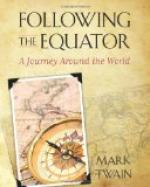manner of arts to win their friendship and get their
confidence. At last, when this was accomplished
to their satisfaction, the real business began.
A few Thugs were privately detached and sent forward
in the dark to select a good killing-place and dig
the graves. When the rest reached the spot a
halt was called, for a rest or a smoke. The
travelers were invited to sit. By signs, the
chief appointed certain Thugs to sit down in front
of the travelers as if to wait upon them, others to
sit down beside them and engage them in conversation,
and certain expert stranglers to stand behind the
travelers and be ready when the signal was given.
The signal was usually some commonplace remark, like
“Bring the tobacco.” Sometimes a
considerable wait ensued after all the actors were
in their places—the chief was biding his
time, in order to make everything sure. Meantime,
the talk droned on, dim figures moved about in the
dull light, peace and tranquility reigned, the travelers
resigned themselves to the pleasant reposefulness
and comfort of the situation, unconscious of the death-angels
standing motionless at their backs. The time
was ripe, now, and the signal came: “Bring
the tobacco.” There was a mute swift movement,
all in the same instant the men at each victim’s
sides seized his hands, the man in front seized his
feet, and pulled, the man at his back whipped the
cloth around his neck and gave it a twist the head
sunk forward, the tragedy was over. The bodies
were stripped and covered up in the graves, the spoil
packed for transportation, then the Thugs gave pious
thanks to Bhowanee, and departed on further holy service.
The Report shows that the travelers moved in exceedingly
small groups —twos, threes, fours, as a
rule; a party with a dozen in it was rare. The
Thugs themselves seem to have been the only people
who moved in force. They went about in gangs
of 10, 15, 25, 40, 60, 100, 150, 200, 250, and one
gang of 310 is mentioned. Considering their numbers,
their catch was not extraordinary—particularly
when you consider that they were not in the least
fastidious, but took anybody they could get, whether
rich or poor, and sometimes even killed children.
Now and then they killed women, but it was considered
sinful to do it, and unlucky. The “season”
was six or eight months long. One season the
half dozen Bundelkand and Gwalior gangs aggregated
712 men, and they murdered 210 people. One season
the Malwa and Kandeish gangs aggregated 702 men, and
they murdered 232. One season the Kandeish and
Berar gangs aggregated 963 men, and they murdered
385 people.
Here is the tally-sheet of a gang of sixty Thugs for
a whole season—gang under two noted chiefs,
“Chotee and Sheik Nungoo from Gwalior”:
“Left Poora, in
Jhansee, and on arrival at Sarora murdered a
traveler.
“On nearly reaching
Bhopal, met 3 Brahmins, and murdered them.
“Cross the Nerbudda;
at a village called Hutteea, murdered a Hindoo.




